- Home
- Orhan Pamuk
The Black Book Page 37
The Black Book Read online
Page 37
Chapter Twenty-eight
THE DISCOVERY OF THE MYSTERY
… the section you are reading interprets the text of your face.
—NIYAZI OF EGYPT
Before starting to read the third section in Mystery of Letters and Loss of Mystery, Galip made himself some strong coffee. He went into the bathroom to splash cold water on his face, hoping it would keep him awake, and somehow managed to keep himself from looking in the mirror. When he sat down at Jelal’s desk with the coffee, he was as keen as a high-school kid getting ready to solve a math problem that had needed solving for quite some time.
According to F. M. Üçüncü, since it was on Turkish soil, in Anatolia, that the imminent advent of the Messiah who would save all the East was to take place, the first step in rediscovering the lost mystery was to firmly establish the correspondences between the lines on the human face and the twenty-nine letter Latin alphabet adopted by the Turkish language after 1928. To this end, extrapolating from obscure Hurufi treatises, Bektaşi poems, Anatolian folk art, phantom ruins of pristine Hurufi villages, figures drawn on dervish lodges and pasha’s mansions, and thousands of calligraphic inscriptions, he had illustrated with examples the “values” some sounds had received as they were being transposed from Arabic and Persian into Turkish; then, displaying a certitude that was awesome, he had identified and marked these letters individually on people’s photographs. When Galip looked at these faces in which, as the writer pointed out, you didn’t need to find the Latin letters in order to read the meaning clearly and precisely, he got the willies just as he had when he was looking at the photographs in Jelal’s cabinet. He was turning pages with some badly printed pictures—the captions said that they were of Fazlallah, his two successors, “the portrait of Rumi copied from a miniature,” and our gold-medalist Olympic wrestler Hamit Kaplan—when he came across a photo of Jelal taken in the late nineteen fifties which gave him a good turn. Letters had also been marked on this photograph, the placement of which, as it had been in others, was indicated by arrows. In this photograph of Jelal, taken when he was around thirty-five, F. M. Uçüncü had detected the letter U on the nose, Z around the eyes, and the letter N sideways on his entire face. Flipping quickly through the pages of the book, Galip saw that there were additional photos belonging to Hurufi masters, famous imams, persons who had had near-death experiences, and to American film actors who had “profoundly meaningful faces,” such as Greta Garbo, Humphrey Bogart, Edward G. Robinson, and Bette Davis, as well as to famous executioners and some of those Beyoğlu hoods whose adventures Jelal had related in his youth. Later, the writer divulged that each letter established by marking it on the face had two discrete meanings: the plain meaning as written and the secret meaning as derived from the face.
Once we accepted that every letter in a face had a hidden meaning that pointed to a concept, F. M. Üçüncü argued, it necessarily followed that every word made up of those letters also had to contain a second, hidden meaning. If one considered that these second meanings could be expressed in other sentences and other words—that is to say, in other letters—then a third meaning could be discovered “through interpretation” to succeed the second, and a fourth could succeed the third and so on ad infinitum, revealing an infinite series of hidden meanings. One could compare this to a network of streets leading into one another: maps that resembled human faces. The reader who attempted to solve the mystery of the letters in human faces in his own way, using his own yardstick, was no different from a traveler who slowly discovers the mystery of a city as he wanders through streets he has seen on a map (a mystery which gets more diffused as it is discovered and is revealed all the more as it gets more diffused), finding the mystery in the streets and paths that he has chosen to walk on, in the flights of steps that he has chosen to climb during his passage through the city and through his life. He, the awaited Saviour, the Messiah, would become manifest at the locus where wistful readers, the downtrodden, the story addicts lose themselves as they become more deeply immersed in the mystery. Somewhere in the middle of life and the text—at the point where faces and maps interfaced—the traveler, armed with keys and ciphers, on receiving the long-awaited signal from the Messiah in the city and in the signs (much like the mystic on the Sufi path), will begin to find his way. He is like someone finding his way with the aid of signposts, as F. M. Üçüncü commented with childlike glee. So the problem, according to F. M. Üçüncü, came down to this: one had to be able to see the signs in life and in the text reposited there by the Messiah. According to him, solving the problem required that we put ourselves in the Messiah’s place, foreseeing how He might behave. Like a chess player, we had to anticipate His moves. Saying that he wished to make this prediction in concert with the reader, F. M. Üçüncü requested that his reader visualize a single individual who had the means to appeal to a large readership at any given time and in any circumstances. “For example,” he added immediately, “a columnist.” A columnist who was read by hundreds of thousands of people on ferries, buses, dolmuşes, in coffee shops and barber shops all over the country was a good example of someone who had the wherewithal to propagate the Messiah’s hidden messages to show us the way. For those who had no inkling of the mystery, this columnist’s texts would carry only a single meaning: the apparent surface meaning. On the other hand, those who awaited the Messiah, and were aware of ciphers and formulas, would be able to read hidden meanings as well, having taken off from the secondary meanings of letters. Let’s say the Messiah included a sentence such as, “Those were the things on my mind as I observed myself from the outside”: while ordinary readers considered the oddness of the apparent meaning, those who were aware of the mystery of letters would immediately surmise that the sentence was the special message they’d been expecting and, armed with their ciphers, they would embark on an adventure that would take them on a brand-new journey and into a brand-new life.
As the title of the third part of F. M. Üçüncü’s book, “The Discovery of the Mystery,” implied, what was being revealed was not only the rediscovery of the idea of mystery, the loss of which had forced the East into slavery vis-à-vis the West, but how to discover the sentences the Messiah reposited in his texts.
Then F. M. Üçüncü surveyed Edgar Allan Poe’s “A Few Words on Secret Writing,” and discussed the cipher formulas proposed in the essay. After pointing out that the method of the reshuffled alphabet was closest to the one employed in the coded correspondence of the Sufi mystic al-Hallaj and was the one which the Messiah would use as well, he had suddenly proclaimed at the end of his book this important conclusion: The starting point of all ciphers and formulas had to be the letters to be found in each traveler’s own face. Anyone who wished to set forth on the road and establish a new universe must begin by discovering the letters in his own face. The modest book the reader held in his hands was a directory for finding these letters, but it was no more than an introduction to the study of the ciphers and formulas that would lead the way to the mystery. Repositing them in the text was, naturally, work reserved for the Messiah who would soon rise like the sun.
No, Galip thought, the word “sun” here signified Rumi’s murdered beloved, Shams of Tabriz, for Shams meant “sun” in Arabic. He flung the book down, ready to go into the bathroom for a good look in the mirror. The thought that had been barely flickering in his mind had now turned into a conspicuous fear: “Jelal must’ve seen the meaning in my face for ages!” He had the same feeling of doom that would come upon him at times in his childhood and first youth, an apprehension that everything was all over, finished, and could never be fixed—when he felt he had done something wrong, turned into someone else, got contaminated by some mystery. “From now on, I am someone else!” Galip thought to himself now, like a child playing a game he knew, but also like someone who has set forth on a road that has no return.
It was twelve past three in the morning; the flat and the city were under the enchanting silence that can only be felt at
that hour—not mere silence, but the feeling of silence, for there was a faint whirring that went through his ears like a twinge, coming from a furnace nearby or the generator on a distant ship. Though he had decided that the time was ripe for him to start on this new road, he would manage to hold off a little longer before he made the move.
Then the thought he’d been trying to forget for the past three days hit him: if Jelal hadn’t managed to send in a new piece, his column would soon be blank. Galip didn’t want to imagine the empty space in place of the column that had never been absent from the second page in all these years—as if the emptiness would mean Rüya and Jelal could no longer be hiding out somewhere in the city, laughing and chatting while they waited for him. Reading a column he pulled out of the cabinet at random, he thought: “I too could write this!” He had a recipe in hand, after all. No, it wasn’t the formula that the old columnist had given him in the editorial rooms three days ago, it was something else: “I know all your work, everything about you; I’ve read and read.” He almost spoke the last word out loud. He went on to read another article he’d pulled out at random. Though it couldn’t be called reading; he was going through the text sounding out the words silently, but his mind was on the secondary meanings in some of the words and letters, and he sensed that the more closely he read, the more closely he was approaching Jelal. What was reading someone’s work, after all, but gradually acquiring the writer’s memory?
He was now ready to look in the mirror and read the letters in his face. He went in the bathroom and took a look. After that, everything happened quickly.
* * *
Much later, after months had gone by, each time Galip sat down at the desk to write, surrounded by objects that silently and reassuringly simulated the past of thirty years ago, he would remember the moment he had first looked in the mirror and the same word would come to his mind: terror. Yet when he first looked in the mirror with playful excitement, he had not yet felt the fearful associations of the word. At that moment, he had had a feeling of emptiness, forgetfulness, and inertia. At that moment, he had looked into his own face reflected in the mirror under the light of a bare bulb as if he were looking at the faces of prime ministers and movie stars he was inured to seeing in the papers. He’d looked into his own face not as if he were solving a mystery, breaking the code of a secret message that he’d been trying to decipher for days, but as if it were an overcoat grown familiar with long wear or an ordinary drab winter morning he’d come to accept, or as if it were an old umbrella he was looking at without really seeing it. “Back then I was so used to living with myself, I wasn’t aware of my face,” he’d think much later on. But the indifference hadn’t lasted long. As soon as he was able to see his face in the mirror in the same way that he saw the faces in F. M. Üçüncü’s book, he instantly began to perceive the shadows of the letters.
The first odd thing he noticed was the fact that he could look in his own face as if looking at a piece of paper with writing on it—as if his face were an inscription that presented signs for the benefit of other eyes and faces; at first he hadn’t dwelled too much on that since he could at last discern the letters that appeared definitively between his eyes and eyebrows. Not too long afterward, the letters became clear enough for him to wonder why he hadn’t been aware of them before. Of course, it had occurred to him that what he was seeing was an aberration produced by looking too long at photographs marked with letters—an optical illusion, or part of a game of illusion played for real—but every time he turned his eyes away and then looked back in the mirror, he saw the letters exactly where he had left them. They did not switch back and forth like the figure-and-ground pictures in kids’ magazines which at first glance appear to show the branches of a tree and then reveal thieves hiding in the branches; there they were, in the topography of the face he shaved absentmindedly every morning—in the eyes, the eyebrows, in the nose where all Hurufis insisted on placing the alif, and in the round surface they termed the facial orbit. It no longer seemed difficult now to read the letters. The hard thing would be not to read them. Galip tried to ignore them in order to liberate himself from the unnerving mask on his face, summoning up the disparaging thoughts he’d prudently kept in readiness in some corner of his mind while he was reviewing Hurufi art and literature, in the hope now of reanimating his skepticism about everything connected with this business of letters and faces—of dismissing all of it as ridiculous, arbitrary, and childish. But the lines and curves in his face signified certain letters so conspicuously that he couldn’t tear himself away from the mirror.
That was when he was seized by the feeling which he later called terror. But everything had happened so quickly, and he’d so readily perceived the letters in his face, and the word signified by those letters, that he would never clearly figure out whether he was first seized by terror because his face had turned into a mask marked with signs, or because he found the meaning the letters implied was so fearful. The letters revealed the mystery that Galip would remember through entirely different words when he wanted to write down the truth he had always known but had struggled to forget, had remembered but assumed he did not, had studied but not taken in. But as soon as he read them definitively in his face without any shadow of a doubt, he had also thought everything was simple and comprehensible; he already knew what he read there, and that he needn’t be astonished. Perhaps what he would later call terror was the surprising nature of plain and simple truth. It was somehow like the unnerving double vision intrinsic to the human mind, which is capable of perceiving with supernal insight the slim-waisted tea glass on the table as an incredible phenomenon while the eye simultaneously takes in the same glass as it has always been.
When Galip decided that what the letters on his face signified was not wide of the mark but right on target, he pulled himself away from the mirror and went out in the hallway. Now he could see that this frightening sensation of his had more to do with what the letters themselves signified—what the signpost that had been placed there pointed to—than with his visage turning into a mask, into someone else’s face, or into a signpost. After all, according to the rules of this fine game, such letters appeared in everyone’s face. As he stooped to look in the shelves of the cabinet in the hallway he felt such profound pain inside him, and he longed for Rüya and Jelal so terribly, that he had a hard time standing up. It was as if his body and soul had abandoned him to suffer for crimes he hadn’t committed; it was as if his memory contained only the mystery of defeat and destruction; it was as if all sorrow and recollection of the past, which everyone else had happily forgotten, were retained in his memory and on his shoulders.
Later, when he wanted to recall what he had done in the first three to five minutes after he’d looked in the mirror—since everything had happened so fast—he would remember the moment when he was standing halfway between the cabinet in the hallway and the window that opened on the shaft of darkness. In the bathroom, when he first felt the “terror,” he had had difficulty breathing; he turned off the light and got away from the mirror in the dark, cold perspiration beading on his forehead. For a moment, there in the hallway, he had imagined that he could go back and plant himself in front of the mirror again, switch the light on, and pull away that thin mask, removing it as if scratching a scab off a wound; he thought that then he would no more be able to find hidden significance in any letters in the face revealed underneath than he could in the letters and signs he saw in ordinary streets, on commonplace billboards, or on plastic bags. Next, he pulled one of Jelal’s pieces out of the cabinet and tried reading it in an effort to overcome his pain, but he already knew everything; he knew everything Jelal had written as if he’d done it himself. He tried imagining, as he would often do later, that he was blind or that, instead of pupils, he had hollowed-out marble holes, instead of a mouth an oven door, and instead of nostrils bolt holes that had rusted. Each time he thought of his face, he realized that Jelal had also seen the letters that appeared in his mind’s
eye, that Jelal had known Galip would someday see them too, and that they had been in collusion playing this game. But he would never know for sure whether he’d been able to think all this through clearly at that moment. He felt as if he couldn’t breathe, nor could he weep, although he wanted to. A moan of pain escaped his throat; his hand automatically reached for the window pull; he wanted to look there, into that shaft of darkness, the void where the well had once existed. He felt like a child impersonating someone whose identity he didn’t know.
He opened the window, leaned into the darkness and, his elbows on the window ledge, pushed his face into the bottomless well of the air shaft: a bad odor rose up, the smell of pigeon droppings that had been accumulating over half a century, of all the crap that had been tossed down, of the building’s grime, of smog, mud, tar, and hopelessness. They’d thrown down here all the things they’d wanted to forget. He had an impulse to jump into the void from which there was no return, into the recollections that had disappeared without a trace from the memories of those who’d once lived here, into the darkness that Jelal had patiently built up in his writing over the years, weaving into it, as in the elaborations of the old courtly poetry, the motifs of wells, mystery, and fear. But he merely stared into the darkness like a drunk trying to remember. The recollections of the childhood he and Rüya had spent together in this apartment building were closely related to this smell; the innocent kid that he had once been, the well-meaning young man, the husband content with his wife, and the ordinary citizen who lived at the edge of mystery were also created by this smell. The desire to be with Jelal and Rüya arose so powerfully inside him that he felt like crying out; it was as if half his body had been ripped from him and taken away to some distant and dark place, as in a dream, and if only he could raise a hue and cry he’d escape from this trap. But he merely stared into the bottomless dark, feeling on his face the damp cold of the winter night and snow. So long as he exposed his face to the dry well of darkness, he sensed that the pain he’d been carrying around alone all these days was being shared, that what was terrifying had become comprehensible, and what he would later come to call the mystery of defeat, misery, and ruin had become manifest like Jelal’s life, the details of which Jelal had prepared long ago like a bait to pull Galip into this trap. There, hanging out the window, he gazed down into the bottomless well for a long time. It was much later, when he became sharply aware of the raw cold on his face, neck, and forehead, that he pulled himself in and closed the window.

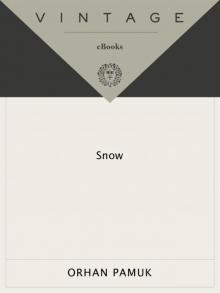 Snow
Snow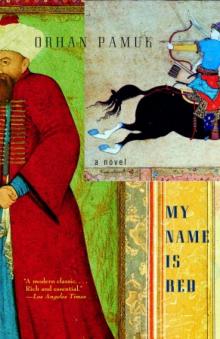 My Name is Red
My Name is Red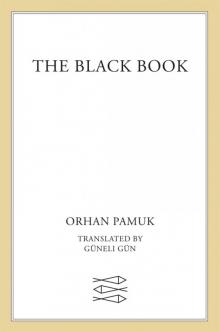 The Black Book
The Black Book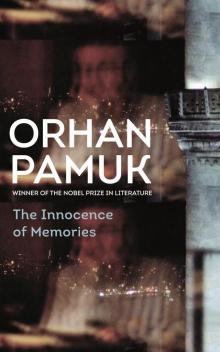 The Innocence of Memories
The Innocence of Memories The White Castle
The White Castle Other Colors
Other Colors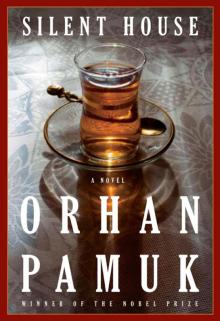 Silent House
Silent House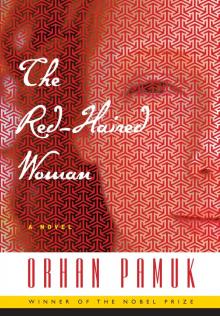 The Red-Haired Woman
The Red-Haired Woman The Museum of Innocence
The Museum of Innocence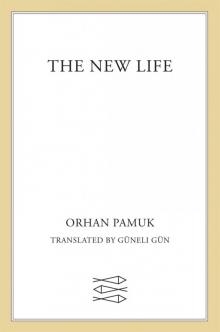 The New Life
The New Life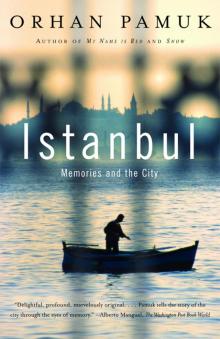 Istanbul
Istanbul